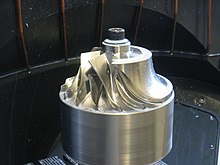Path control
The path control is a control type of CNC machine ( machine tool , robot ). With it several axes are moved at the same time . The tool is guided along a programmed path at a specified speed . The path often consists of straight and circular sections . It can be dependent on the position of another axis or determined by mathematical formulas. It is also called CP control (continuous path) in robotics .
Distinction
A distinction is made regarding the number of simultaneously controlled axes:
- 2D path control: It can control 2 axes in a fixed plane. Use e.g. B. in lathes, laser cutting machines
- 2½D path control: A maximum of 2 axes can be controlled in different levels. Use e.g. B. with simple milling machines. During the movement, the 3rd axis is always in the same position.
- 3D path control: It can move at least 3 axes in space at the same time. Often, rotary, swivel and secondary axes can also be controlled. Use e.g. B. in milling machines and machining centers. The interpolation between the programmed points can be linear , circular in the plane, helical line , spline , or any polynomial according to a mathematical formula.
corrections
The following corrections are often calculated during the movement:
- Tool radius compensation : The finished contour is programmed and the tool center point path is offset outwards or inwards by the value of the cutting edge radius .
- Constant cutting speed: With lathes, the speed increases with small diameters, with milling machines the feed speed is changed at the corners.
- Coordinate transformations: Programming in a coordinate system that is not available as an axis.
- Error compensation of the machine geometry: z. B. backlash, spindle pitch errors, inclined and tilting axes, thermal expansion
Individual evidence
- ↑ Saxon education server: basic structure and mode of operation of a CNC machine. Retrieved November 8, 2019 .
